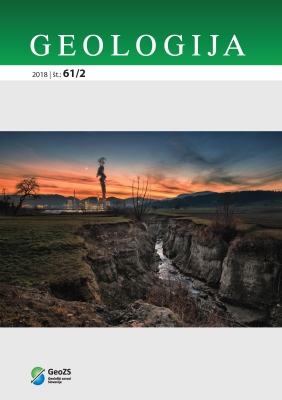Hidrogeološke raziskave plazov Urbas in Čikla nad naseljem Koroška Bela (SZ Slovenija)
DOI:
https://doi.org/10.5474/geologija.2018.013Povzetek
Na območju nad naseljem Koroška Bela je velika nevarnost nastanka pobočnih masnih premikov, kar predstavlja tveganje za varnost naselja. Za razumevanje hidrogeoloških pogojev in procesov, ki lahko vplivajo na masne premike na tem območju, so bile izvedene hidrogeološke raziskave, ki so vključevale hidrogeološko kartiranje, meritve pretokov izvirov ter izvedbo infiltrometrskih in nalivalnih preizkusov. Rezultati raziskav kažejo zapletene in heterogene hidrogeološke razmere, pogojene z geološkimi in tektonskimi značilnostmi širšega območja ter aktivnimi masnimi premiki, ki jih ni mogoče enoznačno opisati. Opazovana velika nihanja pretokov izvirov in gladine podzemne vode v opazovalnih vrtinah so močno odvisna od meteoroloških razmer. Ocenjeni koeficient prepustnosti tal je relativno visok (2×10-4 m/s) in odraža rahla tla z visoko vsebnostjo organske snovi, ki so značilna za gozd. Koeficient prepustnosti bolje prepustnih odsekov vrtin je v splošnem višji v zgornjih delih, v plasteh s prevladujočim gruščem (v razponu med 2×10-3 in 1×10-5 m/s), kot v globljih delih vrtin, v zaglinjenih plasteh (med 3×10-5 in 1×10-7 m/s). Na območju plazu Čikla je ocenjen povprečni koeficient prepustnosti 8.99×10-4 m/s in je višji kot na območju plazu Urbas (3.05×10-4 m/s).Prenosi
Kako citirati
Mitja, J., Luka, S., Dejan, Šram, & Matjaž, K. (2018). Hidrogeološke raziskave plazov Urbas in Čikla nad naseljem Koroška Bela (SZ Slovenija). Geologija, 61(2), 191–203. https://doi.org/10.5474/geologija.2018.013
Številka
Rubrika
Članki

